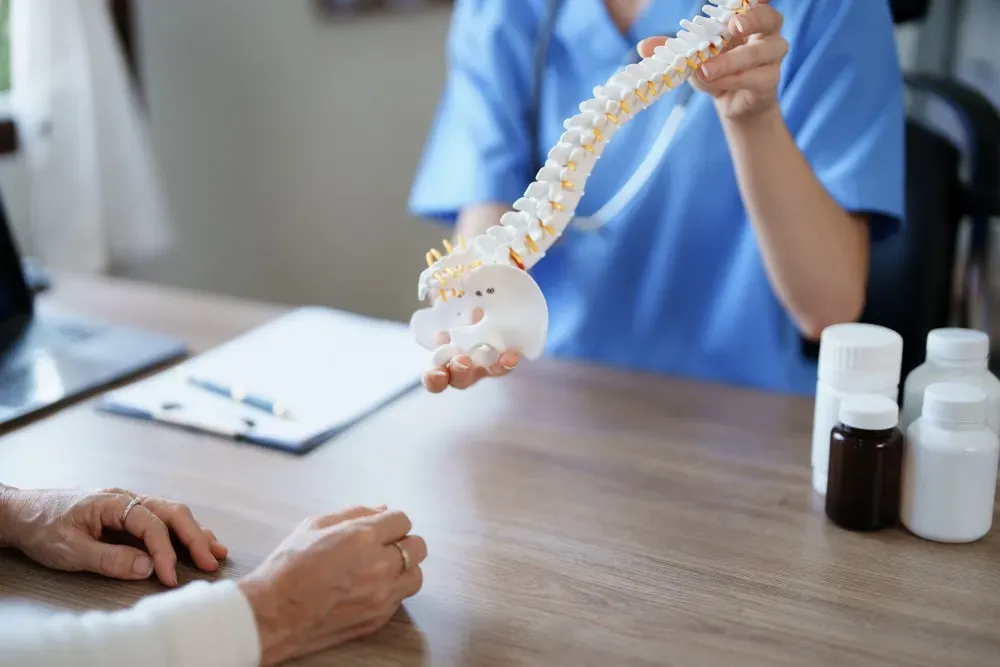Neurosurgery & Orthopedic Surgeons in Jacksonville

5 Causes of Sciatic Nerve Pain
The sciatic nerve is the longest and widest nerve in the human body. It starts in the lumbar spine and branches off to run down each hip, buttock, thigh, calf and foot. The sciatic nerve innervates multiple muscles and skin cells in the lower extremities.
The sciatic nerve is the longest and widest nerve in the human body. It starts in the lumbar spine and branches off to run down each hip, buttock, thigh, calf and foot. The sciatic nerve innervates multiple muscles and skin cells in the lower extremities.
When the sciatic nerve is pinched, irritated, pressed or inflamed, it triggers a set of nerve pain and symptoms known as “sciatica.” Sciatica is a common side effect of multiple conditions that affect the lumbar spine. Keep reading to learn 5 medical conditions that commonly lead to sciatic nerve pain.
WHAT DOES SCIATICA FEEL LIKE?
The hallmark sign of sciatica is one-sided pain that begins in the low back and radiates down the buttock, thigh, calf and foot. Sciatica rarely affects both sides of the body. You can experience symptoms anywhere along the nerve pathway, but pain is usually more severe in the leg and foot than in the low back. Symptoms include:
- Pain that’s described as shooting, burning, stabbing or electric
- Numbness or tingling
- Muscle weakness in the leg or foot
Sciatic pain can be constant or come and go. Movements that aggravate or worsen sciatic pain include coughing, sneezing, standing up, and sitting or standing for long periods of time.
1. BULGING OR HERNIATED DISC
A lumbar bulging or herniated disc is the most common cause of sciatic nerve pain. Research suggests that herniated discs are responsible for 90% of sciatica cases.
Intervertebral discs sit between vertebrae in the spine, providing support, cushioning and shock absorption. Each disc contains a soft, jelly-like nucleus surrounded by a tough outer shell. Age and natural wear and tear over time cause spinal discs to dry out, weaken and develop tiny tears. The supporting ligaments start to weaken as well, causing the disc to slip and bulge out of place. Eventually, pressure and degenerative changes can lead to the jelly-like nucleus leaking out of a tear in the outer shell — a condition called a herniated disc. A herniated disc can also occur suddenly from a traumatic accident like a fall, car crash or sports accident.
A disc that’s bulging out of place can irritate, rub against or place pressure on nearby structures — including the sciatic nerve. Similarly, pieces of a herniated disc can press against or compress the sciatic nerve root. And the jelly-like disc nucleus contains a chemical irritant that causes nerve inflammation when released into the spinal space.
2. BONE SPUR
Bone spur formation is a common side effect of arthritis in the spine. Spinal osteoarthritis causes the breakdown of cartilage in the facet joints that connect vertebrae. When cartilage degeneration occurs, your body’s immune system attempts to repair the damage by triggering new bone growth in the area.
Bone spurs are bony overgrowths that form on the bones of the spine. They cause sciatic nerve pain when they pinch, irritate or press against the sciatic nerve root in the lumbar spine.
3. SPINAL STENOSIS
Spinal stenosis is a medical condition that describes the narrowing of the spaces within the spine. While some people are born with a small spinal canal, most cases of stenosis occur when degenerative changes tighten the open spaces in the spinal canal, through which nerves travel on their way out the spine. A bulging or herniated disc, bone spur, thickened ligaments or inflammation can narrow open spaces in the lumbar spine and pinch or put pressure on the sciatic nerve as it passes through.
4. SPONDYLOLISTHESIS
Spondylolisthesis is a condition that affects vertebrae in the lumbar spine. It occurs when one vertebrae slips forward onto the vertebrae directly beneath it. The displaced vertebra can compress the sciatica nerve or nerve root, causing symptoms of sciatica.
5. TRAUMATIC INJURY
A traumatic low back injury can directly damage, injure, or inflame the sciatic nerve, causing sciatica. Car accidents, falls and sports accidents can lead to injury and nerve damage. Additionally, injuries like fractures, dislocations, bullet wounds, or knife wounds can injure or compress the sciatic nerve.
FIND EXPERT CARE AND TREATMENT FOR SCIATIC NERVE PAIN
If you’re experiencing one-sided back and leg pain, Integrity Spine and Orthopedics will ensure you receive the right diagnosis and treatment. In many cases, sciatica resolves within a few weeks with medications, steroid injections, physical therapy and stretches. If these treatment methods aren’t effective, we’ll discuss minimally invasive surgery to relieve pressure on the compressed nerve.
Our board-certified surgeons specialize in forward-thinking, minimally invasive orthopedic and spine care. We offer conservative therapy, pain management, sports medicine, personal injury, and minimally invasive surgery services to help you get back on your feet and back to doing the activities you love.
We have a convenient clinic located in Jacksonville, FL. Please call us or reach out online to schedule your first appointment.




